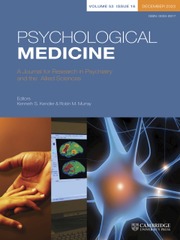Crossref Citations
This article has been cited by the following publications. This list is generated based on data provided by
Crossref.
Scutt, Eleanor
Borgwardt, Stefan
and
Fusar-Poli, Paolo
2019.
Neuroimaging of Schizophrenia and Other Primary Psychotic Disorders.
p.
303.
Qiao, Chen
Lu, Lujia
Yang, Lan
and
Kennedy, Paul J.
2019.
Identifying Brain Abnormalities with Schizophrenia Based on a Hybrid Feature Selection Technology.
Applied Sciences,
Vol. 9,
Issue. 10,
p.
2148.
Gao, Na
Qiao, Chen
Qi, Shun
Ren, Kai
Chen, Jian
and
Fang, Hanfeng
2020.
Intelligent Computing Theories and Application.
Vol. 12464,
Issue. ,
p.
145.
Alamian, Golnoush
Pascarella, Annalisa
Lajnef, Tarek
Knight, Laura
Walters, James
Singh, Krish D.
and
Jerbi, Karim
2020.
Patient, interrupted: MEG oscillation dynamics reveal temporal dysconnectivity in schizophrenia.
NeuroImage: Clinical,
Vol. 28,
Issue. ,
p.
102485.
Vieira, Sandra
Gong, Qiyong
Scarpazza, Cristina
Lui, Su
Huang, Xiaoqi
Crespo-Facorro, Benedicto
Tordesillas-Gutierrez, Diana
de la Foz, Víctor Ortiz-García
Setien-Suero, Esther
Scheepers, Floor
van Haren, Neeltje E.M.
Kahn, René
Reis Marques, Tiago
Ciufolini, Simone
Di Forti, Marta
Murray, Robin M
David, Anthony
Dazzan, Paola
McGuire, Philip
and
Mechelli, Andrea
2021.
Neuroanatomical abnormalities in first-episode psychosis across independent samples: a multi-centre mega-analysis.
Psychological Medicine,
Vol. 51,
Issue. 2,
p.
340.
Li, Qiang
Liu, Sha
Cao, Xiaohua
Li, Zexuan
Fan, Yun-shuang
Wang, Yanfang
Wang, Jiaojian
and
Xu, Yong
2022.
Disassociated and concurrent structural and functional abnormalities in the drug-naïve first-episode early onset schizophrenia.
Brain Imaging and Behavior,
Vol. 16,
Issue. 4,
p.
1627.
Chen, Congxin
Yao, Jingjing
Lv, Yiding
Zhao, Xiaoxin
Zhang, Xinyue
Lei, Jiaxi
Li, Yuan
and
Sui, Yuxiu
2022.
Aberrant Functional Connectivity of the Orbitofrontal Cortex Is Associated With Excited Symptoms in First-Episode Drug-Naïve Patients With Schizophrenia.
Frontiers in Psychiatry,
Vol. 13,
Issue. ,
Xu, Bin
Wei, Shilin
Yin, Xiaojuan
Jin, Xiaokang
Yan, Shizhen
and
Jia, Lina
2023.
The relationship between childhood emotional neglect experience and depressive symptoms and prefrontal resting functional connections in college students: The mediating role of reappraisal strategy.
Frontiers in Behavioral Neuroscience,
Vol. 17,
Issue. ,
Kim, Julia
Song, Jianmeng
Kambari, Yasaman
Plitman, Eric
Shah, Parita
Iwata, Yusuke
Caravaggio, Fernando
Brown, Eric E.
Nakajima, Shinichiro
Chakravarty, M. Mallar
De Luca, Vincenzo
Remington, Gary
Graff-Guerrero, Ariel
and
Gerretsen, Philip
2023.
Cortical thinning in relation to impaired insight into illness in patients with treatment resistant schizophrenia.
Schizophrenia,
Vol. 9,
Issue. 1,
Claus, Jannik
Upadhyay, Neeraj
Maurer, Angelika
Klein, Julian
Scheef, Lukas
Daamen, Marcel
Martin, Jason Anthony
Stirnberg, Rüdiger
Radbruch, Alexander
Attenberger, Ulrike
Stöcker, Tony
and
Boecker, Henning
2023.
Physical Activity Alters Functional Connectivity of Orbitofrontal Cortex Subdivisions in Healthy Young Adults: A Longitudinal fMRI Study.
Healthcare,
Vol. 11,
Issue. 5,
p.
689.
Shen, Chen-Lan
Tsai, Shih-Jen
Lin, Ching-Po
and
Yang, Albert C.
2023.
Progressive brain abnormalities in schizophrenia across different illness periods: a structural and functional MRI study.
Schizophrenia,
Vol. 9,
Issue. 1,
Huang, Huan
Chen, Cheng
Rong, Bei
Zhou, Yuan
Yuan, Wei
Peng, Yunlong
Liu, Zhongchun
Wang, Gaohua
and
Wang, Huiling
2024.
Distinct resting-state functional connectivity of the anterior cingulate cortex subregions in first-episode schizophrenia.
Brain Imaging and Behavior,
Vol. 18,
Issue. 3,
p.
675.


